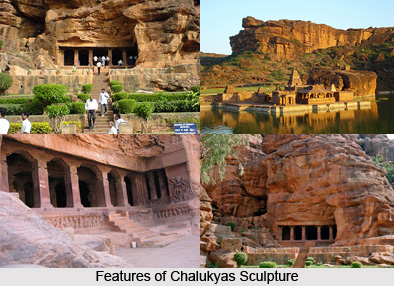 The features of Chalukya sculptures are mainly derived from their temples. The style of the Chalukya sculptures developed in Aihole in around 450 AD. This style was later developed and perfected by Badami and Pattadakal. Interestingly the artists of the Chalukya Empire experimented with different styles. These included the Dravidian art and sculpture and the Indo-Aryan Nagara style. The colossal temples from the Chalukya era are, however, not the earliest ones. The earliest temples of this empire were built with bricks and woods. Unfortunately, though, those temples could not survive the ravages of time.
The features of Chalukya sculptures are mainly derived from their temples. The style of the Chalukya sculptures developed in Aihole in around 450 AD. This style was later developed and perfected by Badami and Pattadakal. Interestingly the artists of the Chalukya Empire experimented with different styles. These included the Dravidian art and sculpture and the Indo-Aryan Nagara style. The colossal temples from the Chalukya era are, however, not the earliest ones. The earliest temples of this empire were built with bricks and woods. Unfortunately, though, those temples could not survive the ravages of time.
The features of Chalukya sculptures can be broadly divided into the Badami Chalukya sculptures and the Western Chalukya (Kalyani) Chalukya sculptures. These divisions are based on the reign of the Chalukya kings. Both these kingdoms have an important part to play in the development of the Deccan sculpture. One of the principle features of the Badami Chalukya sculptures were the rock cut temples. The majority of the wealth of the temples that they have left behind lies in Aihole. The architectures of these structures reflect the experimentation that had been undertaken by the artists while building these Hindu temples. It is during these days that the Chalukya style of building temples evolved. One of the oldest rock temples in Aihole is Ravana Phadi. The principal deity in this temple is a Sivalinga.
According to the features of the Chalukya sculptures they can be divided into three phases. The first phase begins from the 6th century and these structures and their sculptures are concentrated in Aihole. Cave temples were a recurrent feature during these days. The cave temples are simple from outside but the interiors are well ornamented with sculptures, pillared verandahs, mandapa and the cell where the deity is kept.
The second phase begins with temples at Aihole and Badami. This was one of the reasons why Aihole is considered the `cradle of Indian temple architecture.` Perforated stone windows, Buddhist chaitya halls, sculptures of several gods and goddesses are frequent features in these temples. The second phase in the architecture of the Chalukyas brought in more maturity, skill and precision.
The features of the Chalukya sculptures are also prominent in the monuments of the Kalyani kingdom. The features of the Western Chalukya sculptures closely resembled the Dravidian style.



